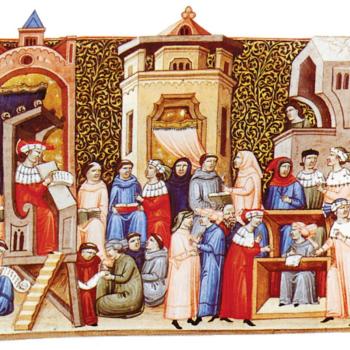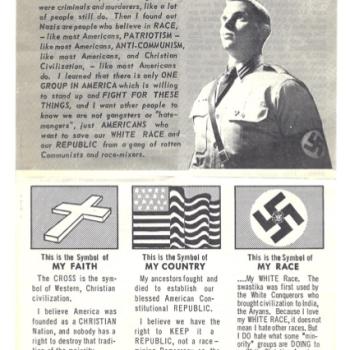As a new academic year gets underway, the writing is on the wall: higher education might well be lurching toward a period of creative destruction of the sort that has affected many other sectors of the economy in recent decades. Mention of “the University of Phoenix” or “MOOCs” or “the Minerva Project” strikes fear in the heart of the tweed-wearing set, just as hand-loom weavers once trembled at the sight of textile mills. But the present moment offers religious college and universities a propitious opportunity. In fact, many have been quietly keeping aloof from the very things that have soured so many on the state of higher education.
The patchwork of faith-based schools in this country is a vital legacy of the American experiment in religious liberty. In the 19th century, when many European nations were centralizing education as a function of the modern state, the United States became a virtual hatchery of private, small church-related liberal arts colleges. From large institutions today such as Notre Dame and Baylor to smaller ones like Providence College, St. Anselm’s, Westmont College, Hope College, Valparsaiso University, or my own institution, Gordon College on Boston’s North Shore, these schools have defied many odds, weathered many crises for the chance to compete in the current predatory eco-system of higher education.
But the changes afoot today also pose challenges. For a brighter future, these schools will need to do more than look enviously at the Ivies or anxiously at their peers; they will have to look within and boldly and creatively articulate what sets them apart.
It begins with people, and not virtual ones. Personal mentoring and leisurely interaction between faculty and students have long been the heart of faith-based education. Neither the soulless PowerPoint-driven lecture hall nor any amount of MOOCs can substitute. Education about things that matter, Aristotle tells us in his Ethics, is often more about emulating a person than mastering a precept. Developing lasting mentors and true friends over the course of four years hardly figures in college rankings. But perhaps it is the factor that matters most.
In loco parentis was perhaps not such a bad idea after all. In a debauched hook-up and drinking campus culture trenchantly dissected in Tom Wolfe’s I Am Charlotte Simmons, curfews, visiting hours, and behavior codes seem not altogether beside the point. My college has all three. Radically, on our campus, men and women still visit separate bathrooms.
Young people are called to a vocation, not a career. Thanks in part to a major grant initiative by the Lilly Endowment to faith-based schools several years ago, the Protestant idea of a “calling” or “vocation” has been reinvigorated; vocation is the new “V-word” on many campuses like mine. Ideas about it vary according to the particular environment, but they share a common vision that 18- and 19-year olds should think of the arc of their lives not primarily in terms of credentials, prestige, or power, but in terms of a calling to a higher good, an orientation of the whole person away from vices such as sloth, pride, and avarice and toward virtues such as justice, prudence, and charity. Many can lead an interesting, distinguished or successful life; few, a good one.
Finally, education is about doubling down on the liberal arts ideal, on what Plato and Platonists ever since have regarded as the exhilarating eros of truth-seeking—something lost on rightist utilitarian approaches to learning and sneered at by guardians of leftist orthodoxy on elite campuses. Great books courses, common core programs, capstone seminars flourish at many religious colleges, in which young people still converse with Augustine, Thomas Aquinas, Maimonides, Erasmus, Pascal, Dostoyevsky, Tocqueville, Jane Austen, and many more. And such figures are not treated simply as benighted foils to our enlightened present nor as fodder for sophisticated deconstruction, but rather in a manner, to quote Donald Kagan, “to keep alive the possibility that the past may contain wisdom useful to the present.”
In the early Middle Ages, monasteries preserved the highest in the classical world for posterity. St. Paul in his letter to the Philippians provided a clear theological rationale for this: “whatever is noble, whatever is right, whatever is pure, whatever is lovely, whatever is admirable—if anything is excellent or praiseworthy—think about such things.” Schools like my own earnestly desire to carry forward this ancient dialogue between Athens and Jerusalem, between intellect and piety.
To be sure, many colleges not explicitly religious share some of the values of religious schools. And religious school themselves are far from perfect. Their rhetoric can exceed their reality, their budgets show much red, they may fail to fully practice what they preach, and some persist in confessional polemics of a bygone era.
But as outliers in the current scene, they harbor much promise. Generally, they evince more political diversity among their faculty than elite schools; they see that a life given to Mammon alone is a hollow one; they recognize the claims of community and tradition; they cherish the eros of learning; they are repositories of moral seriousness in a culture of ironic incredulity. Most importantly, they recognize that the dignity of our humanity, particularly in the realm of learning, longs for a transcendent horizon, a supreme wisdom and highest good–what Dante called “the Love that moves the sun and the other stars.”
(This post originally appeared at Inside Higher Ed on 19 September 2013.)












